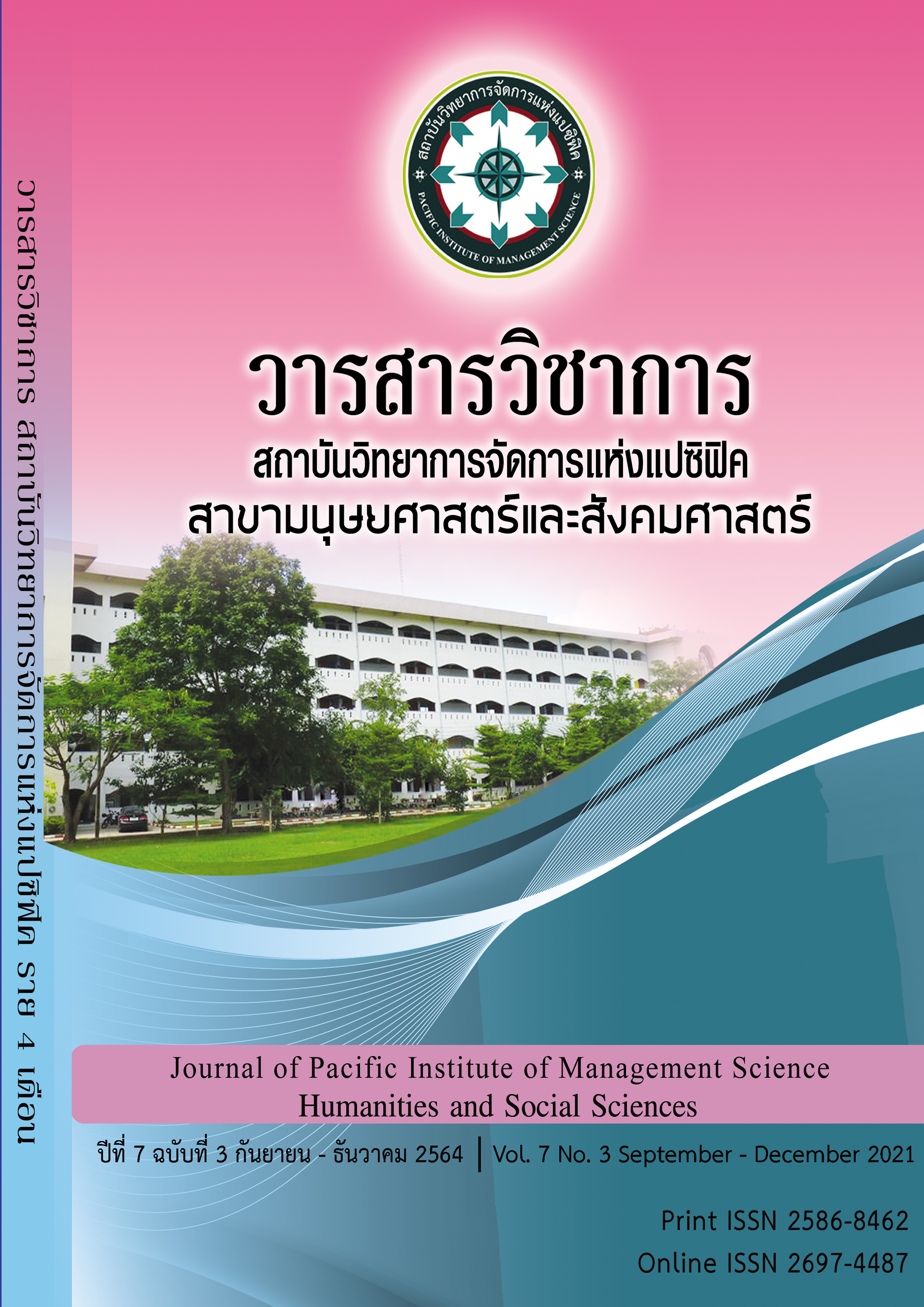ปัจจัยเชิงสาเหตุของการจัดการแบรนด์ในมุมมองของลูกค้า โดยมีคุณลักษณะของลูกค้าเป็นตัวแปรกำกับที่มีอิทธิพลทางตรงและทางอ้อมต่อการตัดสินใจซื้อสินค้าผ่านออนไลน์ของผู้บริโภคในประเทศไทย
คำสำคัญ:
การจัดการแบรนด์ ส่วนประสมทางการตลาดอิเล็กทรอนิกส์ การมุ่งเน้นตลาด คุณลักษณะของลูกค้า การตัดสินใจซื้อสินค้าบทคัดย่อ
การวิจัยครั้งนี้มีวัตถุประสงค์ 1) เพื่อศึกษาปัจจัยเชิงสาเหตุของการจัดการแบรนด์ในมุมมองของลูกค้า 2) เพื่อศึกษาอิทธิพลของปัจจัยเชิงสาเหตุของการจัดการแบรนด์ในมุมมองของลูกค้า 3) เพื่อพัฒนาแบบจำลองของปัจจัยเชิงสาเหตุของการจัดการแบรนด์ในมุมมองของลูกค้า โดยมีคุณลักษณะของลูกค้าเป็นตัวแปรกำกับที่มีอิทธิพลทางตรงและทางอ้อมต่อการตัดสินใจซื้อสินค้าผ่านออนไลน์ของผู้บริโภคในประเทศไทย เป็นการวิจัยแบบผสมผสาน (Mixed Methods) และมีการเก็บรวบรวมข้อมูลด้วยแบบสอบถามออนไลน์ กลุ่มตัวอย่าง จำนวน 510 ราย ใช้การสุ่มตัวอย่างแบบสโนว์บอลล์ (snowball sampling) เก็บข้อมูลตั้งแต่เดือน มกราคม ถึงเดือน กุมภาพันธ์ 2564 การวิเคราะห์ข้อมูลด้วยแบบจำลองสมการโครงสร้าง ผลการวิจัยพบว่า ส่วนประสมทางการตลาดอิเล็กทรอนิกส์มีอิทธิพลทางตรงต่อการจัดการแบรนด์และส่วนประสมทางการตลาดอิเล็กทรอนิกส์มีอิทธิพลทางตรงและทางอ้อมต่อการตัดสินใจซื้อสินค้าผ่านออนไลน์ของผู้บริโภค การมุ่งเน้นตลาดมีอิทธิพลทางตรงต่อการจัดการแบรนด์ และการมุ่งเน้นตลาดมีอิทธิพลทางตรงและทางอ้อมต่อการตัดสินใจซื้อสินค้าผ่านออนไลน์ของผู้บริโภค และการจัดการแบรนด์ในมุมมองของลูกค้ามีอิทธิพลทางตรงต่อการตัดสินใจซื้อสินค้าผ่านออนไลน์ของผู้บริโภคในประเทศไทย
References
กัลยา วานิชย์บัญชา. (2549). หลักสถิติ, กรุงเทพมหานคร: จุฬาลงกรณ์มหาวิทยาลัย
วิชิต อู่อ้น. (2557). การวิจัยและการสืบค้นข้อมูลทางธุรกิจ. กรุงเทพมหานคร: พรินท์แอทมี (ประเทศไทย).
Aaker, D. (1991). Managing Brand Equity. Capitalizing on the Value of a Brand Name. New York: Free Press.
Abd Wahab, N., Hassan, L. F. A., Shahid, S. A. M., & Maon, S. N. (2016).The Relationship Between Marketing Mix And Customer Loyalty In Hijab Industry: The Mediating Effect Of Customer Satisfaction. Procedia Economics and Finance, 37, 366-371.
Agrebi, S., & Jallais, J. (2015). Explain the intention to use smartphones for mobile shopping. Journal of retailing and consumer services, 22, 16-23.
Azam Ferdous, S. M., Udriyah, U., and Tham, J. (2019). The effects of market orientation and innovation on competitive advantage and business performance of textile SMEs. Management Science Letters, 9(9), 1419-1428.
Blackwell, R., Miniard, P., & Engel, J. (2007). Povedenie potrebitelei.[Consumer behavior]. St.Petersburg: Piter Publ.
Blom, A., Lange, F., & Hess Jr, R. L. (2017). Omnichannel-based promotions’ effects on purchasebehavior and brand image. Journal of Retailing and Consumer Services, 39, 286-295.
Chocarro, R., Cortiñas, M. and Villanueva, M. (2013), Situational variables in online versus offline channel choice. Electronic Commerce Research and Applications, 12(5), 347-361.
Christodoulides, G., Cadogan, J., & Veloutsou, V. (2015). Consumer-based brand equity measurement: lessons learned from an international study. International Marketing Review, 32(3/4), 307–328.
Chung, E., & Alagaratnam, S. (2001). Teach ten thousand stars how not to dance: a survey of alternative ontologies in marketing research. Qualitative Market Research: An International Journal, 4(4), 224-234.
Cobb-Walgren, C. J., Ruble, C. A., & Donthu, N. (1995). Brand equity, brand preference, and purchase intent. Journal of advertising, 24(3), 25-40.
Esmaeilpour, M., & Barjoei, S. (2016). The effect of corporate image on customer satisfaction through Brand equity. Advances in Management and Applied Economics, 6(4),95.
Gil, R. B., Andres, E. F., & Salinas, E. M. (2007). Family as a source of consumer‐based brand equity. Journal of product & brand management, 6(2), 54-58.
Hussain, J., Rahman, W., & Shah, F. A. (2016). Market orientation and performance: The interaction effect of entrepreneurial orientation. Pakistan Journal of Commerce and Social Sciences (PJCSS), 10(2), 388-403.
Gregson, N., & Ferdous, R. (2015). Making space for ethical consumption in the South. Geoforum, 67, 244-255.
Gutiérrez Rodríguez, P., Cuesta Valiño, P., & Vázquez Burguete, J. L. (2017). The effects of corporate social responsibility on customer-based brand equity: Spanish hypermarket case. Economic research-Ekonomska istraživanja, 30(1), 290-301.
Ishaq, M. I., Hussain, N., Asim, A. I., & Cheema, L. J. (2014). Brand equity in the Pakistani hotel industry. Revista de Administração de Empresas, 54(3), 284-295.
Jamal Abad, S. G., & Hossein, J. S. (2013). Conceptualization of customer based brand equity in financial service sector. Studies in Business & Economics, 8(1), 123-133.
Jeng, S. P. (2017). Increasing customer purchase intention through product return policies: The pivotal impacts of retailer brand familiarity and product categories. Journal of Retailing and Consumer Services, 39, 182-189.
Jiao, Y., Ertz, M., Jo, M. S., & Sarigollu, E. (2018). Social value, content value, and brand equity in social media brand communities: A comparison of Chinese and US consumers. International Marketing Review, 35(1), 18-41.
Kahn, K. B. (2001). Market orientation, interdepartmental integration, and product development performance. Journal of Product Innovation Management: An international publication of the product development & management association, 18(5), 314-323.
Keller, K. L. (1993). Conceptualizing, measuring, and managing customer-based brand equity. Journal of Marketing Research, 57(4), 1.
Ko, C. H. (2017). Exploring the Relationship of Different Components of Brand Equity in Hotel Industry through Social Networking Sites. The international journal of organizational innovation, 9(3), 47-55.
Kotler, P. (2000) Marketing Management. New Jersey: Person Prentice Hall.
Krishnan, B. C., & Hartline, M. D. (2001). Brand equity: is it more important in services?. Journal of services marketing, 15(5): 328-342.
Kumar, V., Shah, D., & Venkatesan, R. (2006). Managing retailer profitability one customer at a time!. Journal of retailing, 82(4), 277-294.
Latha, R. (2016). Service based brand equity and its impact on brand preferences and purchase intention: A study of customers of health insurance in thanjavur district. International Journal of Research in Commerce & Management, 7(10), 45-53.
Lee, Y. J., Yoon, H. J., & O'Donnell, N. H. (2018). The effects of information cues on perceived legitimacy of companies that promote corporate social responsibility initiatives on social networking sites. Journal of business research, 83, 202-214.
Lim, M., Machado, J. C., & Iglesias, O. (2015). Brand, identity and corporate reputation. Marketing Intelligence & Planning, 33(2), 115.
Lin, J., Lobo, A., & Leckie, C. (2017). The role of benefits and transparency in shaping consumers’ green perceived value, self-brand connection and brand loyalty. Journal of Retailing and Consumer Services, 35, 133-141.
Majumdar, S. (2010, June). Growth strategy in entrepreneur managed small organizations -a study in auto component manufacturing organizations in India. In 2010 IEEE International Conference on Management of Innovation & Technology (pp. 975-982).
Michman, R. D., Mazze, E. M., & Greco, A. J. (2003). Lifestyle marketing: Reaching the new American consumer. Westport, Conn.: Praeger.
Mishra, P., & Datta, B. (2011). Perpetual asset management of customer-based brand equity-The PA Mevaluator. Current Research Journal of Social Sciences, 3(1),
-43.
Narver, J. C., & Slater, S. F. (1990). The effect of a market orientation on business profitability. Journal of marketing, 54(4), 20-35.
Njeru, W. G., & Kibera, F. N. (2014). The perceived effects of the three components of market orientationon the performance of tour firms in Kenya. European Scientific Journal, 10(25), 266-285.
Nowak, L. I., & Washburn, J. H. (2002). Building brand equity: consumer reactions to proactive environmental policies by the winery. International Journal of Wine Marketing, 14(3), 5-19.
Oliver, R. L., Rust, R. T., & Varki, S. (1997). Customer delight: foundations, findings, and managerial insight. Journal of retailing, 73(3), 311-336.
Parasuraman, A. (1985). A Conceptual Model of Service Quality and Its Implications for Future Research. Journal of Marketing, 49(4), 41-50.
Porcu L., del Barrio-García S., Alcántara-Pilar J.M., Crespo-Almendros E. (2017) Examining the Mediating Role of Integrated Marketing Communication on the Relationship between Adhocracy Culture and Brand Advantage. In Advances in Advertising Research (Vol. VII). (pp. 281-295). European Advertising Academy. Springer Gabler, Wiesbaden.
Reynolds, F. D. (1974). An analysis of catalog buying behavior. Journal of Marketing, 38(3), 47-51.
Sarkar, S., & Mishra, P. (2017). Market orientation and customer-based corporate brand equity (CBCBE): A dyadic study of Indian B2B firms. Journal of Strategic Marketing, 25(5-6), 367-383.
Schiffman, L.G., Sherman, E., & Long, M.M. (2003). Toward a better understanding of the interplay of personal values and the Internet. Psychology & Marketing, 20(2), 169-186.
Schreuer, R. (2000). To build brand equity, marketing alone is not enough. Strategy & Leadership, 28(4), 16-20.
Torres, P., & Augusto, M. (2019). Building resilience to negative information and increasing purchase intentions in a digital environment. Journal of Business Research, 101, 528-535.
Tyagi, C. L., & Kumar, A. (2004). Consumer behaviour. New Delhi: Atlantic Publishers & Distributors.
Walsh, J., & Godfrey, S. (2000). The Internet: a new era in customer service. European Management Journal, 18(1), 85-92.
Woodside, A. G., & Waddle, G. L. (1975). Sales effects of in-store advertising. Journal of Advertising Research, 15(3), 29-33.
Wright, L. T., & Nancarrow, C. (1999). Researching international “brand equity”: a case study. International Marketing Review. 16(4/5), 417–431.
Yoh, E., & Gaskill, L. R. (1999). Practitioner Papers: US retail executives' perspectives on the future of retailing. Journal of Fashion Marketing and Management: An International, 3(4), 324-336.
Downloads
เผยแพร่แล้ว
ฉบับ
บท
License
Copyright (c) 2022 สถาบันวิทยาการจัดการแห่งแปซิฟิค

This work is licensed under a Creative Commons Attribution-NonCommercial-NoDerivatives 4.0 International License.
บทความที่ได้รับการตีพิมพ์เป็นลิขสิทธิ์ของ สถาบันวิทยาการจัดการแห่งแปซิฟิค
ข้อความที่ปรากฏในบทความแต่ละเรื่องในวารสารวิชาการเล่มนี้เป็นความคิดเห็นส่วนตัวของผู้เขียนแต่ละท่านไม่เกี่ยวข้องกับสถาบันวิทยาการจัดการแห่งแปซิฟิค และคณาจารย์ท่านอื่นๆในสถาบันฯ แต่อย่างใด ความรับผิดชอบองค์ประกอบทั้งหมดของบทความแต่ละเรื่องเป็นของผู้เขียนแต่ละท่าน หากมีความผิดพลาดใดๆ ผู้เขียนแต่ละท่านจะรับผิดชอบบทความของตนเองแต่ผู้เดียว






